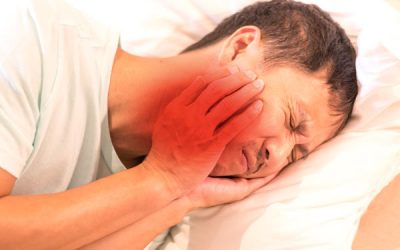This condition causes a localised pain and morning stiffness around the TMJ and is generally associated with a gradual decrease ranges of motion, particularly in month opening movements making simple everyday tasks such as walking and climbing stairs quite difficult.
Bone spur (osteophytes) formation which develops in advance cases of arthritis due to the significant joint deterioration disturbing the natural bone remodelling physiology. Due to the outgrown of the of the joint, adjoining nerves might be irritated and compressed as seen in trigeminal neuralgia and bell’s palsy.
Mechanism of Dysfunction
The predisposing factors for the development of this condition began with a misalignment dysfunction at the TMJ complex, which overtime causes the soft tissue ligamentous and muscle support to become overloaded and compromised allowing the biomechanical stress to reach the level of the cartilage and initiating the degenerative joint disease.
Is important to note that for the cartilage to become injured, the previous defence mechanisms have to have failed to allow the biomechanical stress to damage the cartilage, therefore, the treatment care must aim to restore the health of the entire TMJ protective structures.
Assessment Protocol
The Upper extremity and spinal biomechanical chain must be evaluated as part of the TMJ analyses as per the neurological and mechanical influences of the spine and shoulder.
Clinical assessment to identify the key joint dysfunctions of the jaw that have contributed to this condition. Soft tissue analysis to pinpoint the level of irritation in the soft tissue support.
X-ray analysis
Anterior – Posterior (AP) TMJ view is essential to analyse the level and direction of the different patterns of TMJ misalignments the degree of the degenerative disease
MRI
Jaw MRI is essential for visualizing the extent of injury on the muscle/tendon and ligamentous and cartilage layers
Locate the exact injury point; Allows the treatment to be more specific during the application of the treatment modalities
Identify the extent of tissue damage and the presence of scar tissue; Provides valuable information regarding prognosis and the application of friction soft tissue modalities to aid on scar tissue removal.
Rule out fractures not picked up by the x-ray
Treatment protocol
The treatment care should aim to restore the TMJ alignment, the soft tissue muscles/tendon and ligamentous health as well as stimulating and remodelling the cartilage growth.
Specific adjustments on the TMJ complex followed by a rehabilitation regime to strengthen the entire soft tissue support of the TMJ.
Soft tissue and cartilage healing protocol
Application of Low-level Laser and PEMF directly over the injured tissues to aid on the cellular level of healing as well as improving the microcirculation for the area.
Friction soft tissue therapy helps to reduce dysfunctional scar tissue
Specific stretches and strengthening to improve the resilient of the soft tissue support
Specific selected essential oil application to enhance healing
Dry Needling to promotes blood flow and enhance the soft tissue and cartilage healing.
Depending on the level injury and chronicity, a minimum of 6 weeks up to 12 weeks of treatment care may be necessary to resolve this condition.




